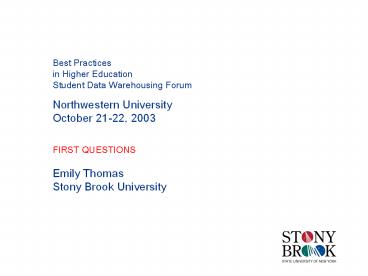Best Practices in Higher Education - PowerPoint PPT Presentation
1 / 15
Title:
Best Practices in Higher Education
Description:
Best Practices in Higher Education Student Data Warehousing Forum Northwestern University October 21-22, 2003 FIRST QUESTIONS Emily Thomas Stony Brook University – PowerPoint PPT presentation
Number of Views:176
Avg rating:3.0/5.0
Title: Best Practices in Higher Education
1
Best Practicesin Higher Education Student Data
Warehousing Forum Northwestern University October
21-22, 2003 FIRST QUESTIONSEmily ThomasStony
Brook University
2
First Questions
- What is a data warehouse?
- Why does a college or university need a student
data warehouse? - What can a college or university do with a
student data warehouse? - What are the dimensions of best practice?
- What, if anything, is different about student
data warehousing?
3
What is a data warehouse?
- A data warehouse is a subject oriented,
integrated, non-volatile, and time variant
collection of data in support of managements
decisions. - (W.H. Inmon, Building the Data Warehouse)
4
What is a data warehouse?
- A data warehouse is a subject oriented,
integrated, non-volatile, and time variant
collection of data to describe an organizations
activities and support of managements decisions.
5
What is a data warehouse?
- A data warehouse is a subject oriented,
integrated, non-volatile, and time variant
collection of derived data to describe an
organizations activities and support of
managements decisions.
6
What is a data warehouse?
- A data warehouse is a subject oriented,
integrated, non-volatile, and time variant
collection of derived data that are managed and
institutionally recognized as a shared data
resource used to describe an organizations
activities and support of managements decisions.
7
What is a data warehouse?
- A data warehouse is a subject oriented,
integrated, non-volatile, and time variant
collection of data in support of managements
decisions. - (W.H. Inmon, Building the Data Warehouse)
- A data warehouse is a subject oriented,
integrated, non-volatile, and time variant
collection of derived data that are managed and
institutionally recognized as a shared data
resource used to describe an organizations
activities and support managements decisions.
8
Technical reasons for a data warehouse
- Production system performance
- Reporting performance
- Consistent data definitions
- Explicit data definitions
- Flexibility
- Frozen data
- Access with multiple tools
- Efficient data storage
9
Organizational reasons for a data warehouse
- Organizations need people to understand them.
- For understanding, people need information.
- For information, people need easy access to good
data.
Information and knowledge are quintessentially
human creations we will never be good at
managing them unless we give people a primary
role. (Thomas Davenport, Information
Ecology)
10
Reporting Dimensions
- Who does the reporting?
- What is the reporting objective?
- Are the questions ad hoc or recurring?
- What is the typical output format?
- What is the timing and source of the data?
- What technical skill and tools does the user have?
11
Reporting Categories
- Operations Management
- Operations Analysis
- Management/Executive Reporting
- Management Analysis
- Analytics
12
Dimensions of Best Practice Data Warehouse
Content and Structure
- What is the content of the data warehouse?
- What reporting periods are used?
- What history is included?
- What is the structure of the data model?
- How many tables are there?
- Are facts and dimensions conformed?
13
Data Management
- How are the source data extracted, transformed,
indexed and loaded? - How are warehouse data refreshed?
- How are warehouse data backed up and recovered?
- How is data quality maintained?
14
Warehouse Management
- Who manages the warehouse?
- What staff effort supports it?
- How was the warehouse designed?
- How are decisions about changes made and
implemented?
15
Warehouse Use
- Is the warehouse an institutional resource?
- Are data marts built from the warehouse?
- How are warehouse data documented?
- How is data access facilitated?
- How is data security maintained?
- What reporting tools are used?
16
What (if anything) is different about student
data warehouses?
- Size small transaction base?
- Period snapshots vs closeouts?
- Longitudinal data especially important?
- Resources limited, but higher education has
Institutional Research?































